Electro Harmonix Mono Synth Handleiding
Electro Harmonix
Niet gecategoriseerd
Mono Synth
Bekijk gratis de handleiding van Electro Harmonix Mono Synth (8 pagina’s), behorend tot de categorie Niet gecategoriseerd. Deze gids werd als nuttig beoordeeld door 22 mensen en kreeg gemiddeld 4.9 sterren uit 11.5 reviews. Heb je een vraag over Electro Harmonix Mono Synth of wil je andere gebruikers van dit product iets vragen? Stel een vraag
Pagina 1/8

MONO SYNTH
Congratulations on your purchase of the Electro-Harmonix Mono Synth. The
Mono Synth allows you to transform your guitar into one of eleven different
synthesizers, from vintage synth emulations, to thick, stacked voices, to deep
pulsing sounds for an array of sonic landscapes and textures. The Mono Synth
was designed to work on your guitar without any modifications or special
pickups. Plug right in and immediately join the ranks of legendary synthesists.
WARNING: Your M S comes equipped with an Electro-Harmonix 9.6DC-200BI ono ynth
power supply (same as used by Boss® & Ibanez®: 9.6 Volts DC 200mA). The M S ono ynth
requires at 9VDC with a center negative plug. Using the wrong adapter or a plug 125mA
with the wrong polarity may damage your M S and void the warranty. ono ynth
GETTING STARTED
Connect the supplied power adapter to the 9V power jack. Plug your instrument
into the INPUT jack. Connect your amp or other effects pedals to the SYNTH
OUTPUT jack. Set the DRY knob to minimum (fully counterclockwise) and set the
other top row knob TYPE and step on the BYPASS s to 12 o’clock. Select a
footswitch to turn on the LED. Play your guitar and adjust controls to your liking.
ONE NOTE AT A TIME
The Mono Synth is a multi-oscillator monophonic instrument. It synthesizes one
note at a time per oscillator. The oscillators have been pre-tuned for each synth
type only TINKER and BLISTER allow for user control over an oscillator. —
Additionally it can handle only one note from your guitar at a time. It does not
work properly when chords or two note intervals are played. The Mono Synth
behaves unpredictably and erratically when it receives more than one note at the
INPUT jack.
SYNTH TYPE DESCRIPTIONS
1. NU WAVE –pulsating string-like synth.
CTRL: the CTRL knob sets the cutoff frequency of the filter .
EXP: the expression pedal sets pitch modulation depth. As the pedal is
swept from heel to toe, modulation depth increases.
2. UNISON –the huge sound of stacking voices on a polyphonic synth.
SENS: higher settings make for wider filter sweeps.
CTRL: controls the volume of a separate oscillator tuned a Perfect 5th
higher than the incoming pitch.
EXP: controls the cutoff frequency of the filter.

3. BLAST –aggressive and resonant synth with deep filter modulation.
SENS: higher settings make for wider filter sweeps.
CTRL: controls the resonance or frequency peak width of the filter.
EXP: controls the frequency range of the filter envelope. The filter’s
frequency range increases as the pedal is swept from heel to toe .
4. TWIN –a throaty, dual filter synth sound.
SENS: higher settings make for wider filter sweeps.
CTRL: sets the decay time of the filter envelopes.
EXP: sweep depth or frequency range. controls the filter envelope’s
5. BASS –octave-down synth for adding low end.
CTRL: adjusts both the decay time and sweep depth of the filter.
EXP: controls the filter’s cutoff frequency. As the pedal is swept from
heel to toe, the cutoff frequency increases.
6. XOX –fast decaying synth reminiscent of the TB.
SENS: higher settings make for wider filter sweeps.
CTRL: sets the decay time of the filter envelope.
EXP: controls the filter’s cutoff frequency.
7. WUB –pulsating synth with a modulating filter.
SENS : higher settings make for wider filter sweeps.
CTRL: sets the speed of modulation.
EXP: controls the filter’s center frequency.
8. TINKER – quirky synth great for bell-like tones.
CTRL: controls the filter’s cutoff frequency.
EXP: controls the pitch of the added note in half-step increments. The
pitch ranges from -1 octave at the heel to +4 octaves at the toe. — — —
9. LAIR –a dramatic, expressive synth with expression filter control.
SENS : higher settings make for wider filter sweeps.
CTRL: adjusts both the filter’s decay time and frequency range.
EXP: controls the filter’s cutoff frequency.
10. GHOST –haunting synth tone with a warbling modulation effect.
CTRL: this knob sets the depth of VCO pitch modulation.
EXP: sets the rate of modulation which increases as the pedals is swept
from heel to toe.
11. BLISTER –piercing synth with an added adjustable pitched note.
CTRL: detunes the oscillator. The noon position yields no detune. Turn
clockwise from noon to detune sharp or counter-clockwise from noon
for flat detune The further you turn from noon, the more detune. .
EXP: controls the pitch of the added note in half-step increments. The
pitch ranges from -1 octave at the heel to + octaves at the toe. — — 4 —

CONTROLS AND I/O JACKS
DRY VOL Knob
The DRY VOL knob controls the volume of the untreated input signal present at
the SYNTH OUTPUT jack.
SYNTH VOL Knob
The SYNTH VOL knob controls the overall volume of the synthesizer sound at the
SYNTH OUTPUT jack.
SENS Knob
The SENS knob (short for sensitivity) adjusts the gain of the input signal before
the signal hits the Mono Synth’s (MS) trigger block. The trigger block MS
generates synth notes that match the pitch your instrument and also resets all of
envelope sweeps only triggers new notes when the input signal exceeds its . It
threshold. Lower settings of SENS will require louder notes to trigger the
synthesizer while higher settings of SENS might trigger new synth notes with
every note you play. The LED lights orange when the input signal to the synth
engine exceeds -4.6dB. Use the LED as an aid when adjusting the SENS knob.
Setting the SENS knob so the LED lights orange on your loudest notes is a good
place to start. Please note: the LED does not indicate when the input signal has
triggered a new note; it lights orange to indicate the loudness output from SENS.
If some of your notes do not trigger the synth, turn up SENS. If you hear many
false triggers or retriggers without playing a new note then turn down SENS.
For all synth types, the gain set by SENS also changes the synth volume over MS
a small range. For some synth types, SENS also adjusts the sweep range of the
filter’s envelope. Higher settings of SENS yield wider filter sweeps and typically
more volume. Check the SYNTH TYPE DESCRIPTIONS on the previous pages to
see which synth type filters are directly affected by the SENS knob.
CTRL Knob
This knob can be used to control a specific parameter for each synth type. See
the SYNTH TYPE DESCRIPTIONS on pages 1 and 2 to learn more.
INPUT Jack
Plug your instrument or the output of another effects pedal into this ¼” jack.
See Tip 1 & 2 on Page for more on connecting your Mono Synth. s 7
DRY OUTPUT Jack
The DRY OUTPUT jack is hardwired to produce a buffered version of the signal
present at the INPUT jack. In either or BYPASS mode, the dry signal is EFFECT
always present at the DRY OUTPUT jack. The DRY knob change the does not
volume of the signal at the DRY output jack.
SYNTH TPUT Jack OU
The SYNTH OUTPUT jack produce the mix set by the DRY and SYNTH volume s
controls. In BYPASS mode, SYNTH OUTPUT outputs the buffered bypass signal.
Product specificaties
| Merk: | Electro Harmonix |
| Categorie: | Niet gecategoriseerd |
| Model: | Mono Synth |
Heb je hulp nodig?
Als je hulp nodig hebt met Electro Harmonix Mono Synth stel dan hieronder een vraag en andere gebruikers zullen je antwoorden
Handleiding Niet gecategoriseerd Electro Harmonix
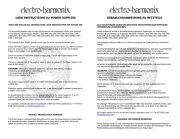
5 Augustus 2025
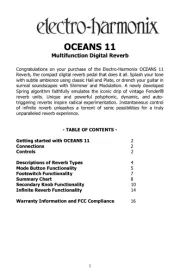
5 Augustus 2025
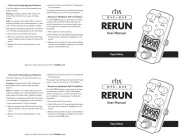
5 Augustus 2025
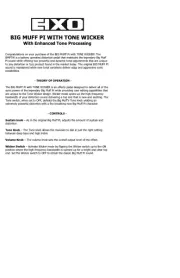
5 Augustus 2025
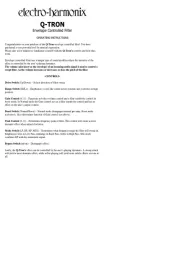
5 Augustus 2025
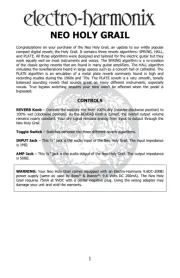
4 Augustus 2025
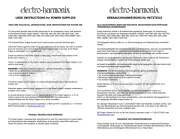
4 Augustus 2025
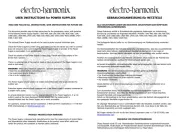
4 Augustus 2025
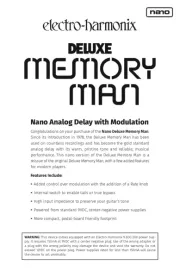
4 Augustus 2025
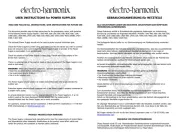
4 Augustus 2025
Handleiding Niet gecategoriseerd
- Advance Acoustic
- MOZOS
- MGL Avionics
- PXN
- Phase One
- Shark
- Cosatto
- Joovy
- AJA
- Ubbink
- GEEKOM
- Ardes
- EcoFlow
- Oertli
- Match
Nieuwste handleidingen voor Niet gecategoriseerd

14 September 2025

14 September 2025

13 September 2025

13 September 2025

13 September 2025

13 September 2025

13 September 2025

13 September 2025

13 September 2025

13 September 2025